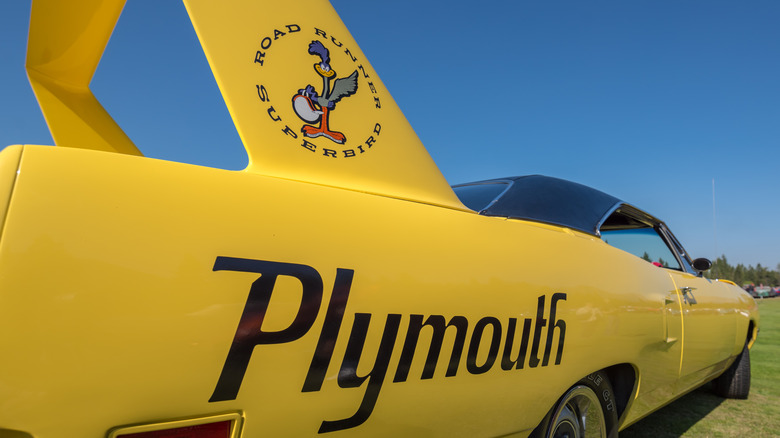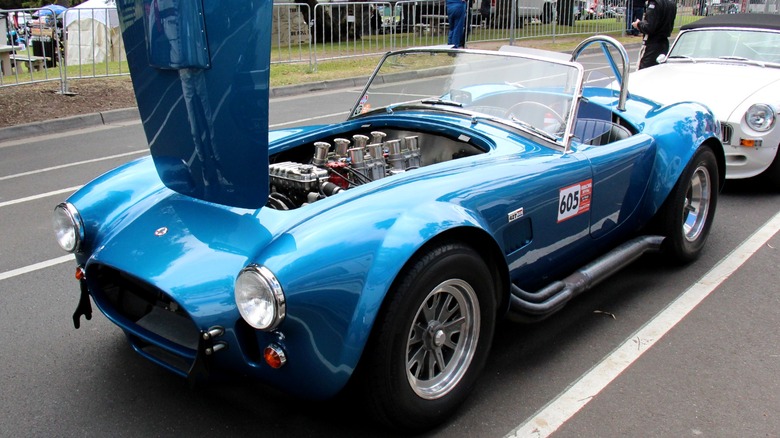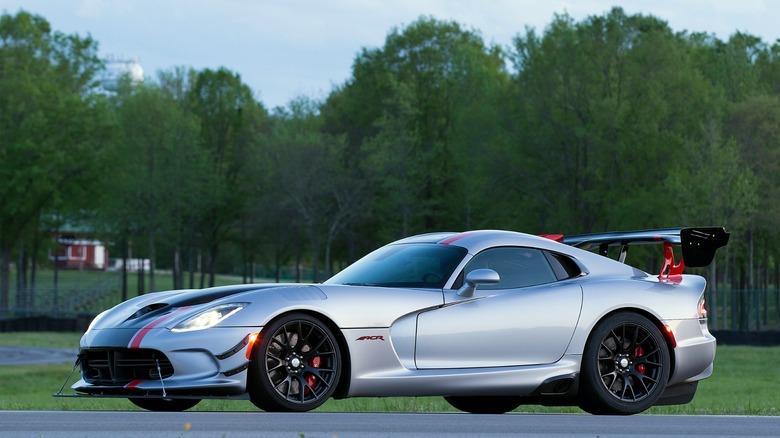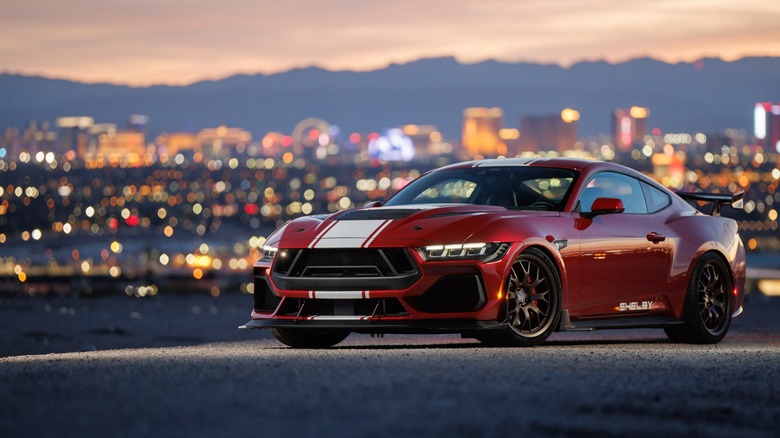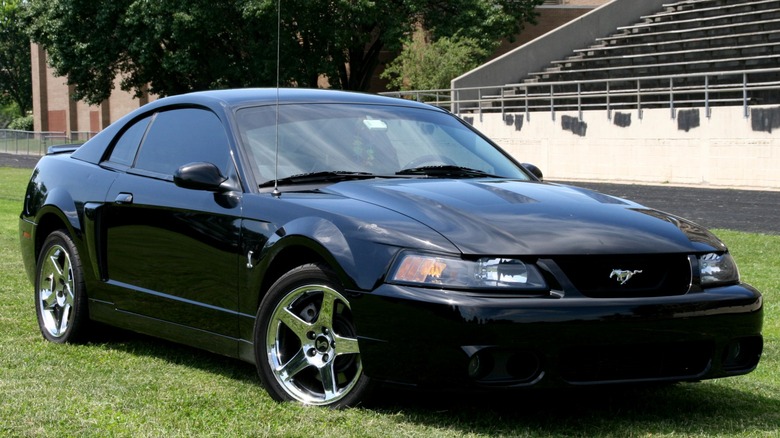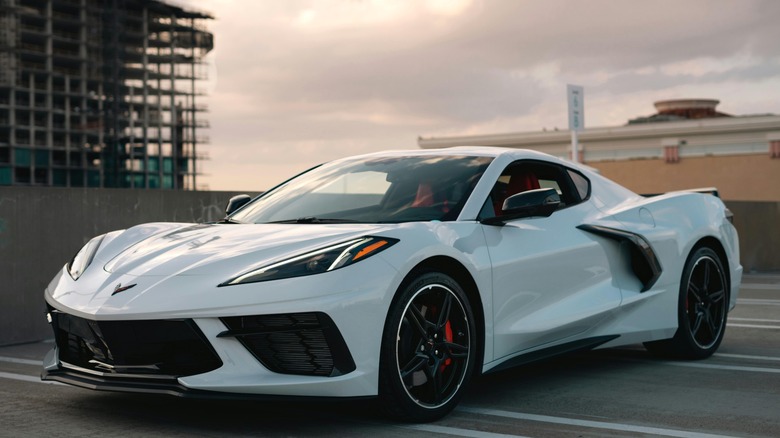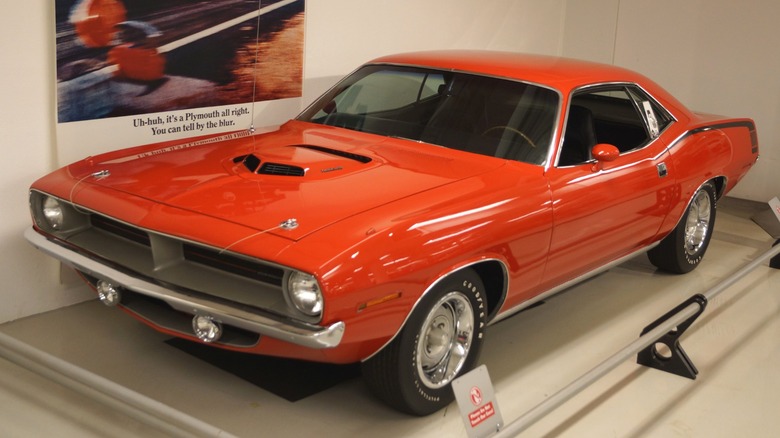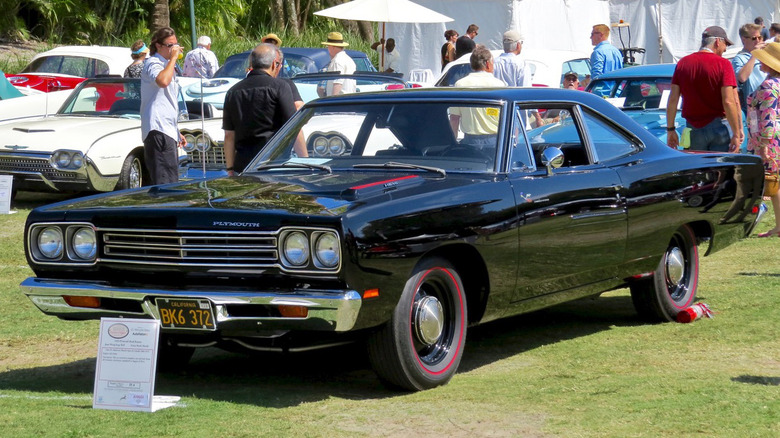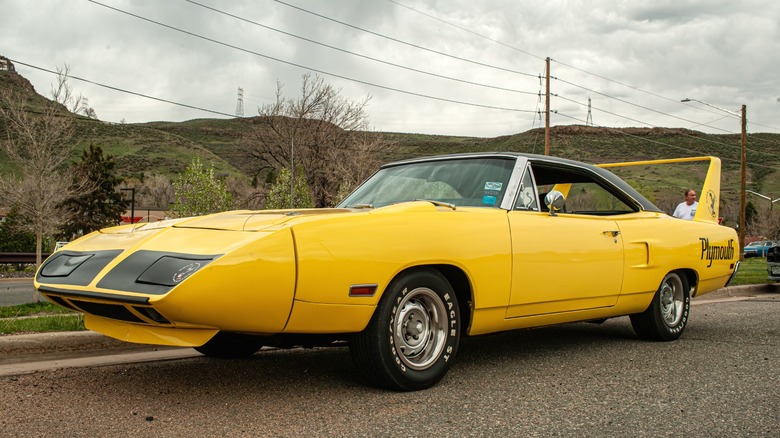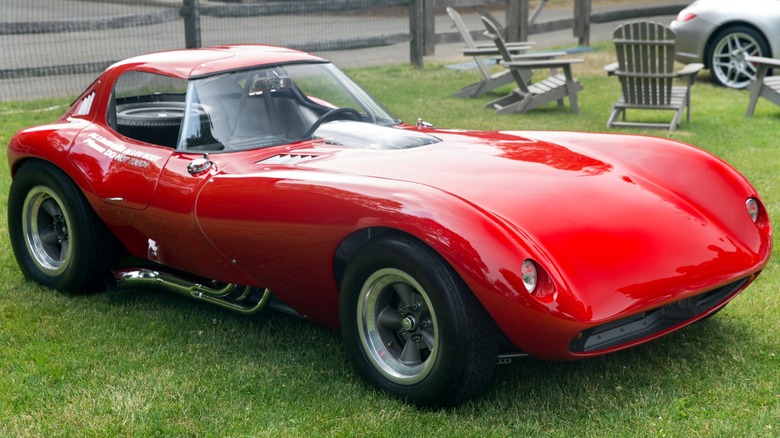10 Of The Wildest Muscle Cars Named After Animals
Automakers have historically drawn inspiration from all manner of sources when naming their cars, but one of the most fruitful sources of names has to be the animal kingdom. There has been a long lineage of cars named after animals, from those named after predators such as the Shelby Cobra or Corvette Stingray to more sedate, friendlier ones such as the Volkswagen Rabbit and Fiat Panda. Some companies even name their cars after individual animals, like Lamborghini and its Muciélago, named after the bull that allegedly sired the Miura bulls — which, of course, gave their name to the world's first and greatest supercar, the Lamborghini Miura.
But, as great as they are, we'll have to leave megabucks European supercars for another time. For now, let's stick to a category that has featured more animal-inspired names than you can shake a stick at: the muscle car. We've mentioned the Shelby Cobra and Corvette Stingray, but those are just the tip of the iceberg: after all, who can forget classics like the Dodge Viper or Plymouth Superbird? And we're not just covering old-school muscle, either, as new offerings like Ford's crazy Mustang GTD and the Shelby Super Snake continue to fly the flag for that intoxicating combination of big V8 power, rear-wheel drive, and animal-derived names. Let's get going.
Shelby 427 Cobra
We start with undoubtedly one of the most iconic muscle cars to bear the name of an animal: Carroll Shelby's Mark III 427 Cobra. The 427 was the pinnacle of the Cobras, which Shelby first started building in 1963. They were rowdy cars from the get-go, the combination of Ford V8 power and a lightweight body making for excellent quarter-mile times and a lot of tire smoke, even with the relatively tame 260- and 289-CI engines that powered the Mark I and Mark II Cobras.
The Cobra proved successful enough that AC Cars — the British company building the bodies — stopped making the original car and focused solely on building Cobra bodies. But Shelby wasn't content with the Mark II's success and began experimenting with even larger engines, eventually landing on Ford's 427-CI V8, which made over 400 horsepower and nearly 500 lb-ft of torque.
The 427 allowed the Cobra to hit 60 mph in under five seconds and to do the 0 – 100 – 0 mph run in under 14, both of which are impressive numbers for 1965. It also made the Cobra somewhat tough to handle, with even modern recreations proving a handful to drive quickly. Spare a thought, then, for the crazy souls who ordered the Competition 427 Cobra, which must have been terrifying to drive thanks to its 600 horsepower. Shelby built 23 of these Competition Cobras, 31 S/C cars, and around 100 standard Cobras with the 427 before swapping to a tamer 428-CI Police Interceptor V8 — although the 427 returned for the final 50 units or so.
Dodge Viper ACR
From the Cobra, we come to the Dodge Viper. The Viper was then-president Bob Lutz's attempt to build a Cobra-style performance car for the 1990s, and stood out on its 1992 debut for its massive 8.0-liter V10 engine, curvy Cobra-inspired styling, and brutally bare-bones design. It didn't have a roof or side windows, and the interior was spartan even by 1992 standards.
The first-generation Viper, then, was already something of a wild offering, especially from a mainstream automaker like Chrysler. In some ways, none of the following revisions lived up to the first model in terms of sheer outrageousness, with models like the 1996 second-gen Vipers boasting safer handling, more creature comforts, and conventional rear exhausts. But they also had more power, which was a sign of the path that would culminate in our pick of the bunch: the third-gen Viper ACR from 2016.
Where the original Viper was an atavistic, simplistic throwback to a different age, the 2016 Viper ACR was an ultra-modern, high-performance track car with a ton of spoilers, oodles of downforce, and a whole lot of performance. By this time, the 8.4-liter V10 was making 645 horsepower and 600 lb-ft of torque, which, coupled with the ACR's aero and grip, made for an extremely capable track car. So while the Dodge Viper, a fan-favorite supercar, is sadly no more, we can at least be happy it went out on a high.
Ford Mustang GTD
We go from snakes to horses to discuss the latest — and possibly greatest — version of the iconic Ford Mustang to date: the Mustang GTD. The GTD, which Ford announced in 2023 for the 2025 model year, is a supercar take on the Mustang developed alongside the Mustang GT3 race car.
Any way you look at it, the GTD is a cut above the Mustangs most of us know and love. On the outside, we have that huge rear wing, which looks like it belongs on the track and not the street; the sharp, muscular swathes of carbon fiber that make up the body; and lightweight magnesium wheels. Look underneath the skin, though, and the GTD arguably gets even more impressive: it sports features such as a semi-active suspension system, carbon ceramic brakes, adjustable traction control, an eight-speed rear-transaxle transmission, and, most crucially, an even more powerful version of the standard Mustang engine.
The GTD's supercharged 5.2-liter V8 makes 815 horsepower and 664 lb-ft of torque, which is allegedly good enough to take the car to a top speed of 202 mph. That makes it the fastest Ford Mustang to date, but the GTD is capable of more than just straight-line speed: The GTD also handles brilliantly, with the suspension trickery and downforce combining for a Nürburgring lap time of 6:57. It's one of the few road cars to break past the seven-minute barrier, sharing that rarefied air with cars like Porsche's astounding 911 GT3 — proving that the Mustang GTD is truly a cut above the average Mustang.
Shelby Super Snake
The GTD isn't the only 800+ horsepower Mustang out there, though: as day follows night and summer follows spring, each new generation of the Ford Mustang is a chance for Shelby American to showcase its prowess at designing and building high-performance versions of Ford's pony car. And that's precisely what it did with the limited-to-250 2024 Shelby Super Snake, one of the most powerful Shelby vehicles to date.
First unveiled at Barrett-Jackson's Palm Beach auction in 2024, the Super Snake is available in two versions: the first sticks to the seventh-generation Mustang GT's 480-horsepower 5.0-liter V8, while the higher-performance version slaps a 3.0-liter supercharger onto that same engine to generate a Mustang GTD-bothering 830 (or more) horsepower from that same Coyote V8 engine. The supercharged Coyote also gets a larger radiator and heat exchanger, allowing lucky owners to keep the pedal to the metal without worrying about overheating.
Shelby American engineers didn't just crank the power up, though: The Super Snake sports new Shelby suspension and Brembo brakes for better cornering and stopping, while aluminum and carbon fiber body panels help shed some pounds and give the Super Snake a much more aggressive look. Shelby also specced a Borla exhaust for the Super Snake, which should make it as much of a joy to listen to as to drive. It'll probably never be as iconic — and highly sought-after — as the original 1967 Super Snake, but one thing's for sure: this snake has fangs.
Ford Mustang SVT Cobra
We've discussed Mustangs and Cobras, so why not cover a car that carries the names of both animals? Enter the Ford Mustang SVT Cobra, which Ford's Special Vehicle Team built from 1993 to 2004 across two generations of the Mustang. But while the 1993 Ford Mustang SVT Cobra R is undoubtedly the holy grail Fox Body for most Mustang enthusiasts, the model we have in mind here is the 2003 – 2004 Mustang SVT Cobra, better known as the Terminator.
This final iteration of the Mustang SVT Cobra took the aggressive lines of the "New Edge" fourth-generation Mustang and gave them a powerplant to match, with the SVT team installing an Eaton supercharger on a cast-iron version of Ford's 4.6-liter V8. Combined with other necessary changes such as forged pistons, forged connecting rods, new cylinder heads, and new camshafts, the now-supercharged V8 made 390 horsepower and 390 pound-feet of torque. This was a healthy 100-plus horsepower increase over the standard Mustang GT's 260 horsepower, allowing for 0-60 mph times of under five seconds.
As with other souped-up Mustangs, the 2003 Ford Mustang SVT Cobra also received some suspension upgrades to ensure it could hold its own around corners, too. Bilstein shocks and Brembo brakes were standard, while revised spring rates helped the Cobra handle the engine's extra power. Owners who wanted even more attention could also get their 2004 Cobras in Mystichrome, an iridescent color that shifted between green, blue, purple, and black depending on the lighting. Ford only built 1,010 of these, making them exceedingly rare.
Chevrolet Corvette Stingray
We've covered quite a few Fords thus far, so it makes sense to look at GM's premier animal-named offering, the Chevrolet Corvette Stingray. The Stingray name has a long history, with GM first using it in 1963 for the then-new Corvette C2. These second-generation Corvettes were called the Sting Ray, a reference to the all-new — and vaguely aquatic — design language for the new generation.
Chevrolet switched to "Stingray" for the 1969 C3 Corvette, which further emphasized the C2 'Vette's fish-like design by introducing an even more flowing body with huge fender flares that added a lot of muscle to the Corvette's lines. But while the C3 looked the part, GM eventually had to bow down to edicts such as the 1970 Clean Air Act, leading to the C3 and its low-powered engines becoming one of the least-liked Chevy Corvette generations.
Why are we including the Stingray on the list, then? That has everything to do with the current eighth-generation Chevrolet Corvette, whose entry-level model bears the Stingray name. But don't mistake "entry-level" to imply that the new Corvette Stingray is pedestrian; in fact, it's anything but: The 2024 Chevrolet Corvette Stingray matches a healthy 495-horsepower V8 to great handling and a surprising amount of refinement, with the total package offering supercar-rivaling performance at a relatively accessible price. So while it's not a crazy, tire-spinning beast like the Shelby 427 Cobra or a Nürburgring monster like the Ford Mustang GTD, it more than holds its own in this menagerie of high-powered muscle cars.
Plymouth Hemi 'Cuda
Time to turn the clock back again, this time to the 1970s and a trio of cars that used a street version of the 426 Hemi engine. First up is the Hemi 'Cuda, a Hemi-equipped version of the high-performance 'Cuda version of the Barracuda, which debuted as a trim level for the second-generation E-body version of the pony car in 1970.
Until then, Barracuda owners had to make do with smaller engines, with the constricted engine bay limiting the car to a 330-horsepower, 383-CI V8 at best. But that all changed when Chrysler introduced a bigger Barracuda in 1970, which sacrificed some of the first-generation Barracuda's nimble handling to be able to fit much bigger engines. And so, 1970 saw Plymouth start offering the 'Cuda trim, which came as standard with a 335-horsepower version 383 V8 but could be optioned with one of three 400-plus-CI engines, chief of which was the 426 Hemi.
The 426 Hemi wasn't the biggest engine owners could opt for in the 'Cuda — that honor goes to the 440-CI V8 — but it was definitely the most powerful. The 440 V8, even in its hot six-pack configuration, only made 390 horsepower; the Hemi made 425 horsepower and 490 pound-feet of torque, although the real output may have been closer to 500 horsepower. — plenty of power, especially in a simplistic muscle car like the 'Cuda. Plymouth only built the Hemi 'Cuda for two years, with the engine gone from the options list by 1973.
Plymouth Road Runner
Compared to the Barracuda, the Road Runner was a veritable newcomer to the Plymouth stable by the time the company decided to stuff the 426 Hemi into its engine bay. Whereas the Barracuda had debuted a handful of weeks before the Mustang in 1964, the Road Runner debuted toward the end of the so-called golden era of muscle cars in 1968.
The Road Runner — technically named after the cartoon character, not the bird, but we think it counts — was a budget-minded affair, Plymouth attempting to offer a lot of speed for not a lot of money. To that end, it debuted with a special version of Plymouth's 383-CI V8 under the hood, which was good for 335 horsepower and 480 pound-feet of torque. But the Road Runner had more to offer if buyers had the money: relatively well-heeled speed-freaks — the Hemi option cost $714.30, nearly a quarter of the car's base price — could opt for the 426 Hemi from the get-go, with its 425 horsepower and 490 pound-feet of torque capable of getting a Road Runner down the quarter mile in 13.5 seconds and to 60 mph in around five seconds.
That doesn't sound too impressive now, especially not when the fastest electric cars on the market have completely altered our frames of reference for acceleration and top speed figures. But the 1960s were a radically different time, and the Hemi was good enough for Car and Driver to call the Road Runner a "breathtaking" car in a contemporary review.
Plymouth Superbird
We're stretching things a little here, admittedly, given that there's no such thing as a "superbird" in real life. But, really, would anyone turn down a chance to talk about the Plymouth Superbird if given a chance? Not likely.
The Superbird was essentially a Plymouth Road Runner, retaining the original car's Looney Tunes Road Runner branding and the optional 426 Hemi, although most were optioned with one of two 440-CI engines: Out of the 1,935 Superbirds built in 1970, only 135 left the factory with the smaller Hemi V8. The main difference was in the body, which featured a new nose and rear wing similar to that of the contemporary Dodge Charger Daytona. Plymouth designers made some tweaks to the Daytona's styling, though, adjusting the nose and wing to be more aesthetically pleasing. Unfortunately, these adjustments made the Superbird slightly slower than the Daytona, although it still managed to hit 200 mph at Talladega in 1970. It wasn't unusably slow, then, even if it wasn't as fast as it could have been.
The reduced top speed didn't stop Richard Petty, though. The legendary driver, who'd left for Ford in 1968, switched back to Plymouth in 1970 and his team ran several Superbirds that year. Petty himself won 18 races that year in Superbirds and more conventional Road Runners. This success was short-lived, though: NASCAR banned winged cars like the Superbird after the 1970 season, limiting winged cars to 305-CI engines in 1971.
Bill Thomas Cheetah
We end our list of speedy animals with a rare one that many of you may never have heard of: the Bill Thomas Cheetah. The Cheetah was originally designed and built by Californian Bill Thomas in the 1960s. Thomas, who had made a name for himself souping up GM cars, conceived of the Cheetah as a direct response to Carroll Shelby's Cobras, which burst onto the scene in 1962 and laid waste to the competition — including GM's Corvettes.
GM's decision to pull out of racing in 1963 would have stopped lesser mortals, but not Bill Thomas. He allegedly pulled some strings and got the green light to build a limited-run vehicle to compete with the Cobra — and The Cheetah was that car. It was a mix of Corvette parts — such as the rear suspension and 327-CI V8 — and custom frame and suspension work, all encased in a flowing fiberglass body. Performance was great, with the 1500-pound Cheetah hitting 185 mph in the quarter mile and 215 mph at Daytona. Handling was a whole other story, though, with wild wheelspin and a tendency to oversteer.
The Cheetah won quite a few races that year despite its touchy handling, although its limited production numbers meant it raced in a different class than its Shelby rival. Unfortunately for Thomas and the Cheetah, new homologation regulations — requiring 1,000 cars instead of just 100 — in 1964, combined with a workshop fire, meant that the Cheetah never really got off the ground: only around 20 originals were ever built, with only eight thought to have survived to this day.
